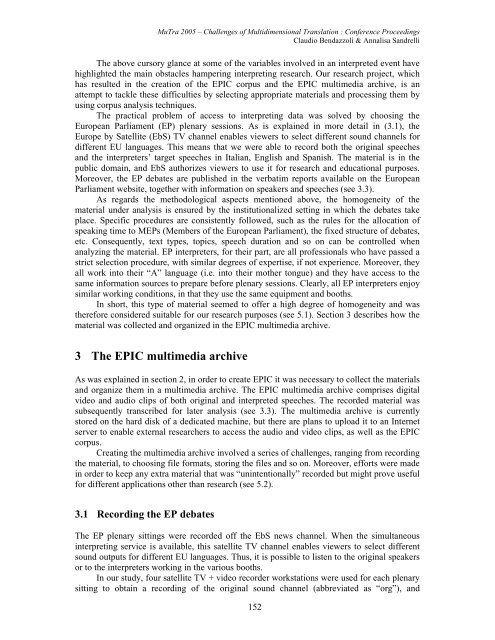Proceedings - Translation Concepts
Proceedings - Translation Concepts
Proceedings - Translation Concepts
Create successful ePaper yourself
Turn your PDF publications into a flip-book with our unique Google optimized e-Paper software.
MuTra 2005 – Challenges of Multidimensional <strong>Translation</strong> : Conference <strong>Proceedings</strong><br />
Claudio Bendazzoli & Annalisa Sandrelli<br />
The above cursory glance at some of the variables involved in an interpreted event have<br />
highlighted the main obstacles hampering interpreting research. Our research project, which<br />
has resulted in the creation of the EPIC corpus and the EPIC multimedia archive, is an<br />
attempt to tackle these difficulties by selecting appropriate materials and processing them by<br />
using corpus analysis techniques.<br />
The practical problem of access to interpreting data was solved by choosing the<br />
European Parliament (EP) plenary sessions. As is explained in more detail in (3.1), the<br />
Europe by Satellite (EbS) TV channel enables viewers to select different sound channels for<br />
different EU languages. This means that we were able to record both the original speeches<br />
and the interpreters’ target speeches in Italian, English and Spanish. The material is in the<br />
public domain, and EbS authorizes viewers to use it for research and educational purposes.<br />
Moreover, the EP debates are published in the verbatim reports available on the European<br />
Parliament website, together with information on speakers and speeches (see 3.3).<br />
As regards the methodological aspects mentioned above, the homogeneity of the<br />
material under analysis is ensured by the institutionalized setting in which the debates take<br />
place. Specific procedures are consistently followed, such as the rules for the allocation of<br />
speaking time to MEPs (Members of the European Parliament), the fixed structure of debates,<br />
etc. Consequently, text types, topics, speech duration and so on can be controlled when<br />
analyzing the material. EP interpreters, for their part, are all professionals who have passed a<br />
strict selection procedure, with similar degrees of expertise, if not experience. Moreover, they<br />
all work into their “A” language (i.e. into their mother tongue) and they have access to the<br />
same information sources to prepare before plenary sessions. Clearly, all EP interpreters enjoy<br />
similar working conditions, in that they use the same equipment and booths.<br />
In short, this type of material seemed to offer a high degree of homogeneity and was<br />
therefore considered suitable for our research purposes (see 5.1). Section 3 describes how the<br />
material was collected and organized in the EPIC multimedia archive.<br />
3 The EPIC multimedia archive<br />
As was explained in section 2, in order to create EPIC it was necessary to collect the materials<br />
and organize them in a multimedia archive. The EPIC multimedia archive comprises digital<br />
video and audio clips of both original and interpreted speeches. The recorded material was<br />
subsequently transcribed for later analysis (see 3.3). The multimedia archive is currently<br />
stored on the hard disk of a dedicated machine, but there are plans to upload it to an Internet<br />
server to enable external researchers to access the audio and video clips, as well as the EPIC<br />
corpus.<br />
Creating the multimedia archive involved a series of challenges, ranging from recording<br />
the material, to choosing file formats, storing the files and so on. Moreover, efforts were made<br />
in order to keep any extra material that was “unintentionally” recorded but might prove useful<br />
for different applications other than research (see 5.2).<br />
3.1 Recording the EP debates<br />
The EP plenary sittings were recorded off the EbS news channel. When the simultaneous<br />
interpreting service is available, this satellite TV channel enables viewers to select different<br />
sound outputs for different EU languages. Thus, it is possible to listen to the original speakers<br />
or to the interpreters working in the various booths.<br />
In our study, four satellite TV + video recorder workstations were used for each plenary<br />
sitting to obtain a recording of the original sound channel (abbreviated as “org”), and<br />
152
















